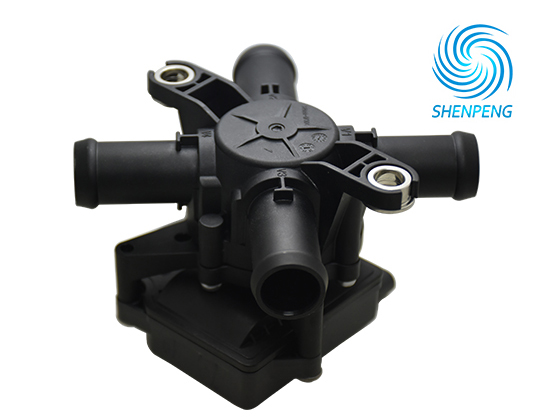Unveiling the Working Principle of Automotive Electronic Water Valves
Published:2025-09-08

An automotive electronic water valve may seem unassuming, but it acts as the "intelligent regulating valve" in the cooling system—every movement influences the vehicle's thermal balance. To understand how it works, let’s start with its critical role in the system.
The Core Role in Cooling Circulation
As a key node connecting the engine, radiator, and heater core, the electronic water valve precisely controls the coolant’s flow path and volume based on real-time driving conditions. This process relies on a sophisticated "signal reception-instruction execution-status feedback" logic chain.
The Journey of a Control Signal
When the vehicle starts, sensors (e.g., engine temperature sensors, AC controllers) act as "scouts," transmitting real-time data—such as engine block temperature, cabin set temperature, and ambient temperature—to the ECU (Electronic Control Unit), the car’s "brain." After processing, the ECU sends electrical signals to the water valve, specifying the required valve opening (0%-100% stepless adjustment) or flow path switching.
Advanced Driving Technologies from Shenpeng Technology
Shenpeng Technology’s water valves stand out for their rapid response, thanks to two Mainstream driving technologies:
1. Electromagnetic Drive: Utilizes magnetic force from coils to move the valve core in milliseconds, ideal for scenarios requiring quick switching.
2. Motor Drive: Employs precision gear sets for delicate control, achieving ±1% accuracy—perfect for stable flow regulation in complex conditions.
The Mechanics of Valve Movement
When the ECU signals "increase flow," the drive component compresses a spring to expand the valve’s flow channel, directing more coolant to the radiator. For "decrease flow," the spring pushes the core back to narrow the channel or even cut off certain loops, prioritizing internal engine circulation (e.g., fast warm-up during cold starts). In multi-way valves (such as Y/T-type 3-way, 4-way, or 5-way valves), core rotation/translation switches flow paths—flexibly allocating coolant between engine cooling and cabin heating.
Precision Engineering for Reliability
Shenpeng Technology ensures accuracy and stability through meticulous design:
1. Micron-level Machining: The valve core and seat fit tightly to prevent coolant leakage.
2. Specialized Surface Treatment: Reduces flow resistance and noise within the valve body.
3. Closed-loop Feedback: An integrated position sensor monitors the core’s status in real time, sending data back to the ECU for continuous adjustment—maintaining high-precision control.
Real-World Application Scenarios
1. Cold Start: The valve blocks the radiator path, circulating coolant only in the engine to speed up warm-up—30% faster than traditional mechanical valves.
2. High-Speed Driving: Fully opens the radiator channel while adjusting heater core flow to balance engine cooling and cabin comfort.
3. AC Heating: Directs a precise amount of coolant to the heater core, delivering quick and consistent warmth via the blower.
The Advantage of Intelligent Control
This "sense-decide-act" mechanism breaks free from traditional mechanical valves’ passive regulation. Shenpeng Technology enhances efficiency through optimized drive technology, improved sealing, and refined algorithms:
1. Rapid Response: Completes adjustments within 0.5 seconds from signal reception.
2. Extreme Environment Resistance: Functions smoothly at -40°C to 125°C, ensuring reliable performance in all conditions.
In essence, every opening/closing of an automotive electronic water valve represents sophisticated thermal management. Shenpeng Technology’s expertise lies in perfecting this process—delivering precision, speed, and durability for modern vehicle systems.
- Distribution in Water Heater Mattresses: Why BLDC Pumps Ensure Uniform Heating
- How BLDC Pumps Ensure Precise Flow in Water Dispensers
- Why BLDC Pumps Are Essential for Smart Toilets
- The Critical Role of Automotive Electronic Water Pumps in New Energy Vehicle Battery Thermal Management
- Noise Control Technology for Smart Toilet Water Pumps: Enhancing Quiet Operation in Modern Bathrooms
- Unveiling the Working Principle of Automotive Electronic Water Valves
- Comparative Analysis of Liquid-Cooled Pumps vs. Air-Cooled Systems for EV Charging Stations
- Technical Application of Brushless DC Motors in Energy Storage Circulation Pumps
- Water Heater Pump: Efficiency Upgrade for Low-Voltage Systems
- How Dishwasher Water Pumps Enhance Cleaning Coverage Through Stable Operation?
